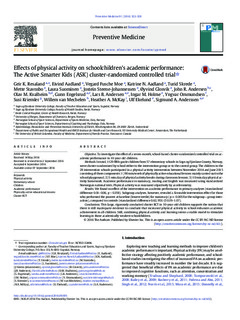| dc.contributor.author | Resaland, Geir Kåre | |
| dc.contributor.author | Aadland, Eivind | |
| dc.contributor.author | Moe, Vegard Fusche | |
| dc.contributor.author | Aadland, Katrine Nyvoll | |
| dc.contributor.author | Skrede, Turid | |
| dc.contributor.author | Stavnsbo, Mette | |
| dc.contributor.author | Suominen, Laura | |
| dc.contributor.author | Steene-Johannessen, Jostein | |
| dc.contributor.author | Glosvik, Øyvind | |
| dc.contributor.author | Andersen, John Roger | |
| dc.contributor.author | Kvalheim, Olav M. | |
| dc.contributor.author | Engelsrud, Gunn | |
| dc.contributor.author | Andersen, Lars Bo | |
| dc.contributor.author | Holme, Ingar Morten K. | |
| dc.contributor.author | Ommundsen, Yngvar | |
| dc.contributor.author | Kriemler, Susi | |
| dc.contributor.author | van Mechelen, Willem | |
| dc.contributor.author | McKay, Heather A. | |
| dc.contributor.author | Ekelund, Ulf | |
| dc.contributor.author | Anderssen, Sigmund A. | |
| dc.date.accessioned | 2016-10-06T09:37:03Z | |
| dc.date.available | 2016-10-06T09:37:03Z | |
| dc.date.issued | 2016-09-07 | |
| dc.identifier.citation | Preventive Medicine. 2016, 91, 322-328 | nb_NO |
| dc.identifier.uri | http://hdl.handle.net/11250/2413216 | |
| dc.description | © 2016 The Author(s). This is an Open Access article. | |
| dc.description.abstract | Objective: To investigate the effect of a seven-month, school-based cluster-randomized controlled trial on academic performance in 10-year-old children.
Methods: In total, 1129 fifth-grade children from 57 elementary schools in Sogn og Fjordane County, Norway, were cluster-randomized by school either to the intervention group or to the control group. The children in the 28 intervention schools participated in a physical activity intervention between November 2014 and June 2015 consisting of three components: 1) 90 min/week of physically active educational lessons mainly carried out in the school playground; 2) 5 min/day of physical activity breaks during classroomlessons; 3) 10 min/day physical activity homework. Academic performance in numeracy, reading and English was measured using standardized Norwegian national tests. Physical activity was measured objectively by accelerometry.
Results: We found no effect of the intervention on academic performance in primary analyses (standardized difference 0.01–0.06, p N 0.358). Subgroup analyses, however, revealed a favorable intervention effect for those who performed the poorest at baseline (lowest tertile) for numeracy (p=0.005 for the subgroup ∗ group interaction), compared to controls (standardized difference 0.62, 95% CI 0.19–1.07).
Conclusions: This large, rigorously conducted cluster RCT in 10-year-old children supports the notion that there is still inadequate evidence to conclude that increased physical activity in school enhances academic achievement in all children. Still, combining physical activity and learning seems a viable model to stimulate learning in those academically weakest schoolchildren. | nb_NO |
| dc.language.iso | eng | nb_NO |
| dc.publisher | Elsevier | nb_NO |
| dc.subject | physical activity | nb_NO |
| dc.subject | elementary school | nb_NO |
| dc.subject | children | nb_NO |
| dc.subject | academic performance | nb_NO |
| dc.subject | physically active educational lessons | nb_NO |
| dc.subject | Cluster RCT | nb_NO |
| dc.title | Effects of physical activity on schoolchildren's academic performance : The Active Smarter Kids (ASK) cluster-randomized controlled trial | nb_NO |
| dc.type | Journal article | nb_NO |
| dc.type | Peer reviewed | nb_NO |
| dc.subject.nsi | VDP::Medical disciplines: 700 | nb_NO |
| dc.source.journal | Preventive Medicine | nb_NO |
| dc.identifier.doi | http://dx.doi.org/10.1016/j.ypmed.2016.09.005 | |
| dc.description.localcode | Seksjon for kroppsøving og pedagogikk / Department of Physical Education | nb_NO |
